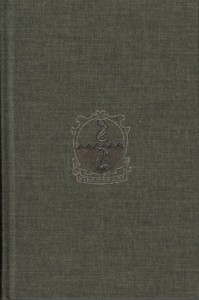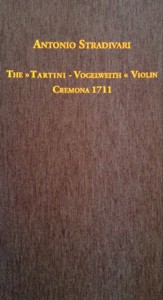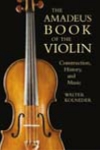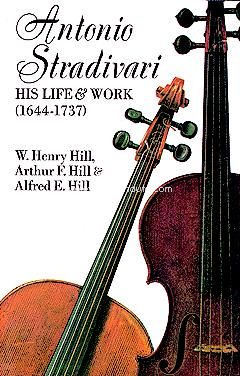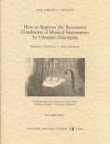
How to Improve the Resonance Conditions of Musical Instruments by Vibration-Dedamping, Elimination of Wolf Notes, Other Adjustments
Reumont, Gerhard A. V.
Henry Strobel. 1999Ficha técnica
- EAN: 9781892210029
- ISBN: 978-1-892210-02-9
- Editorial: Henry Strobel
- Fecha de edición: 1999
- Encuadernación: Rústica
- Dimensiones: 22x28
- Idioma: Inglés
- Traductor: Lothar Tews
- Nº páginas: 63
Agotado
Agotado en la editorialPVP. 34,40€
Añadir a la Lista de deseos
Describes the author's twenty-five years of experience and the methods and equipment he used to "play-in" string instruments. (Only for experts who can properly evaluate this process.)
CONTENIDO:
(Publisher's Preface to the English Edition)
1. Foreword to the First Edition
1.1 Table of Contents
2. Patent Rights, Theory and Principles
2.1 The patent covering the application of "vibration- dedamping" to improve the resonance of instruments, other related patents
2.2 Theoretical principles
2.3 Comments
2.4 When is a vibration-dedamping treatment appropriate?
2.4.1 New unplayed instruments
2.4.2 Older instruments after long storage
2.4.3 Instruments after repairs
3. Characteristics of Various instruments
3.1 Characteristics of string instruments
3.1.1 Characteristics of string instruments with soundposts
3.1.2 Characteristics of string instruments without soundposts
3.2 Characteristics of wind instruments
3.3 Considerations for playing-in concert halls and studios
4. Required Equipment and Facilities
4.1 The power source (DC power supply)
4.2 Vibrators
4.2.1 Vibrators for cellos and double basses
4.2.2 Vibrators for violins and violas
4.2.3 Vibrators for guitars
4.2.4 Vibrators for pianos, grand pianos and other keyboard instruments
4.2.5 Vibrators for wind instruments
4.2.6 Vibrators for zithers
4.3 Vibration measuring equipment
4.3.1 Photoelectric and infrared equipment
4.3.2 Stroboscope
4.4 Treatment room
5. Attaching the Vibrator Correctly, Operating the Equipment, and Conducting a Vibration De-damping Treatment
5.1 Treatment of a double bass
5.l.1 Hanging up an instrument
5,1.2 Preparations for a V-DD treatment
5.1.3 The treatment procedure
5.2 Vibration-dedamping of a cello
5.3 Treatment of violins and violas
5.4 Treatment of guitars and other plucked instruments
5.5 Treatment of keyboard instruments
5.6 Treatment of other instruments
5.7 Treatment of several instruments at the same time
5.7.1 Treatment of several instruments with a treatment report
5.7.2 Semi-automatic treatment without report
6. Treatment of Wolf Tones
6.1 Eliminating a so-called "false wolf tone"
6.2 Finding the area affected by the wolf tone vibrations and eliminating a real wolf tone
7. Research Results on the V -DD Method
7.1 How climatic conditions affect the internal tensions and as a result the resonance characteristics of musical instruments, and what can be done to reduce the sensitivity of musical instruments to these influences
7.1.1 Description of the experiment
7.1.2 Summary of the results and conclusions
7.2 Investigation of the wolf tone in string instruments
7.2.1 What is a wolf tone; what does it actually do?
7.2.2 A method for find the location of the wolf resonator and for eliminating the wolf tone
7.3 Treatment of tonewood and instrument parts
7.4 Reproducibility of the results and how long they are effective
8. More Information on the V-DD Method
8.1 Instructions for making the equipment
8.1.1 Building the direct current power supply
8.1.2 Vibrators for double basses and cellos
8.1.3 Vibrators for violins and violas
8.1.4 Vibrators for guitars
8.1.5 Vibrators for pianos and other keyboard Instruments
8.1.6 Other vibrators
8.2 A little about the cost
8.2.1 The cost of the equipment
8.2.2 The cost to the musician
8.3 Comments from musicians
8.4 In closing .
References (Bibliography)
Appendix 1 - Original Patent (German) .
Appendix 2 - Patent Test Report (German) 0
Appendix 2 - Patent Test Report (English) ,
(Additional Notes, Lothar Tews) .
("Afterwords," Henry Strobel)


